Latter-day Saints aren't the only ones who have spoken from the podium of the Salt Lake Tabernacle. Many US Presidents have as well. In honor of President's Day, we are resharing this 2017 article with a few interesting details behind each of their visits to this historic Temple Square building.
1. John F. Kennedy
On September 26, 1963, President John F. Kennedy arrived in Salt Lake City and gave a historic speech in the Tabernacle on Temple Square as the President of the United States.
Though he had also spoken in that historic building three years earlier as a presidential candidate, referencing Joseph Smith, Brigham Young, and Latter-day Saint scripture, during his 1963 visit, the president spoke powerfully of creating a united nation and a united world. In some of his opening lines, he shared:
“Of all the stories of American pioneers and settlers, none is more inspiring than the Mormon trail. The qualities of the founders of this community are the qualities that we seek in America, the qualities which we like to feel this country has, courage, patience, faith, self-reliance, perseverance, and, above all, an unflagging determination to see the right prevail.”
He later stated, “As the Mormons succeeded, so America can succeed, if we will not give up or turn back.” Just shy of two months later, President Kennedy was shot and killed in Dallas, Texas.
2. President Theodore Roosevelt
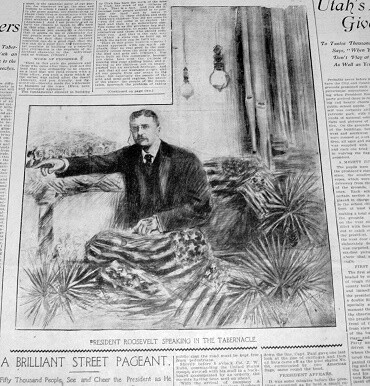
Photo from The Deseret News, used by permission
Though not the first president to visit Salt Lake, President Theodore “Teddy” Roosevelt was the first president of the United States to speak at the Tabernacle, which he did on May 29, 1903. In his address, he praised the unity of the people of Utah, along with their wise use of resources:
“[Y]ou have exemplified a doctrine which it seems to me all-essential for our people ever to keep fresh in their minds—the fact that though natural resources can do a good deal, that the law can do a good deal, the fundamental requisite in building up prosperity and civilization is the requisite of individual character in the individual man or woman. . . You took a state which at the outset was called after the desert, and you literally—not figuratively—you literally made the wilderness blossom as the rose.”
3. William Howard Taft
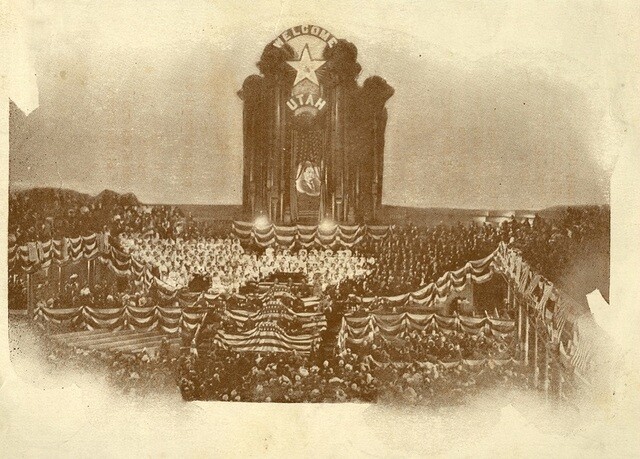
Photo courtesy of Ronald L. Fox
President Taft first addressed an audience in the Tabernacle on a Sunday morning, September 26, 1909. He started by saying:
“I thank you from the bottom of my heart for this expression of welcome and good will. I have been oppressed since I have come into this magnificent structure with the thought that you had gathered here in part to hear me, and that I have nothing to address to you worthy of such magnificent presence. . . . Yet I have felt that on this Sunday morning it was necessary for me to make such effort as I could to follow [my predecessor] in something that may sound a bit like a sermon. And as sermons are begun with the quotation of a text, having more or less relation to what follows it, I am going to give you the text from Proverbs: 'A soft answer turneth away wrath, but grievous words stir up anger.'”
Towards the end of his speech, he added:
“My friends, I can not in the presence of so great an audience as this, an audience that inspires one with higher thought of country and patriotism, fail to refer to the depth of feeling that has been awakened in me, of gratitude for your welcome, of an appreciation of the basis of that welcome which is loyalty to your flag and country.”
During President Taft’s second visit to the Tabernacle in October 1911, he spoke to a gathering of elderly Utah residents. At that gathering, the Tabernacle Choir provided most of the music while Bishop C. W. Nibley conducted and introduced the President.
4. Woodrow Wilson

Photo from When the White House Comes to Zion, courtesy of Ronald L. Fox
When President Woodrow Wilson arrived in Salt Lake City in September 1919, he was not feeling well and canceled all of his scheduled appointments except—for his Tabernacle speech and a meeting with Relief Society President Emmeline B. Wells, who had helped coordinate the government’s purchase of 200,000 bushels of wheat from the Relief Society during World War I. He would suffer a stroke less than one month later.
President Woodrow Wilson’s speech in the Tabernacle was an attempt to gain the support of the American people for the League of Nations—part of the peace treaty organized at the end of WWI. One notable quote that likely particularly resonated with the Latter-day Saints spoke of moral obligations:
“There is no force to oblige the United States to do anything except moral force. Is any man, any proud American, afraid that the United States will resist the duress of duty? I am intensely conscious of the great conscience of this Nation. I see the inevitableness, as well as the dignity and the greatness, of such declarations as President Grant has made aligning all the great organized moral forces of the world on the same side. It is inconceivable they should be on different sides.”
5. Warren G. Harding
Photo from When the White House Comes to Zion, courtesy of Ronald L. Fox
June 26, 1923
President Warren G. Harding stopped in Salt Lake City as part of a westward journey towards Alaska. He spoke in the Salt Lake Tabernacle on a Tuesday evening on June 26, 1923, about “Taxation and Expenditure.” In his introduction to his speech, he paid the following compliment to Utahans:
“I cannot tell you how happy you have made us. There could come to nobody in the world a more gracious, cordial, and heartening reception than you have given us in your wonderful State and beautiful city. I almost wish I were not President, for I should like to fling aside my manuscript and just talk to you.”
He then closed his speech with:
“Let us have a new hope and a new promise, and let us be in a position to say to our children and their children that life is not encouraged for the purpose of sacrifice but for that greater accomplishment which is becoming in the eyes of God Almighty.”
6. Herbert C. Hoover

Photo courtesy of Ronald L. Fox
While campaigning for reelection in Utah, President Herbert Hoover addressed over 10,000 people in the Salt Lake Tabernacle on November 7, 1932. He started by referencing his Utah roots:
“This is by no means my first visit to Salt Lake City. I came from the West, and one of my first professional engagements was the responsibility of carrying a chain and driving stakes on a ditch line in this State.
“It has been a great relief and great stimulation in the last two days to come back to the West where I was born and reared. So I come to your State as no stranger.”
He, of course, addressed concerns connected to the severe economic depression of the time and his determination to avoid war:
“I see war's fatal poison subtly invading the moral ideals of the people, bringing grossness and cynicism where should grow the fine flower of idealism. The world has seen enough of a postwar peace that is not peace, but rather smolders on in racial hatreds.
“For these reasons, it has been a major purpose through all of my administration to guide the foreign policy of this Nation so as to maintain our traditional peace with amity with all nations.”
7. Franklin D. Roosevelt
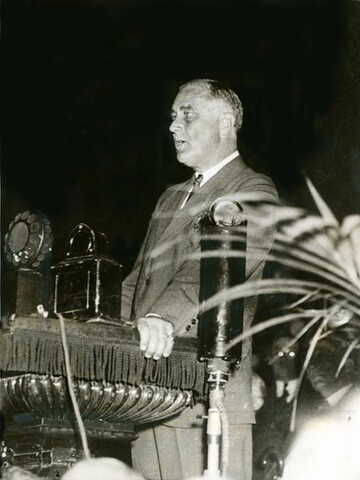
Photo from Ronald L. Fox
September 17, 1932
While governor of New York, President Franklin D. Roosevelt stopped in Salt Lake City to give a campaign speech in the Tabernacle on September 17, 1932. Like those who spoke there before and those after him, Governor Roosevelt was highly complimentary of the hospitality and kindness of the people of Utah and praised its pioneer heritage:
“My visit here in Salt Lake City is, I assure you, one of the brightest spots of a happy trip. As I have viewed the scene in this Valley, it is easy to see how a distinguished citizen of your State, arriving in this place eighty-five years ago, exclaimed: This is the place! And every time I come back to it I want to pay a new tribute to those splendid American pioneers who made it possible in the early days.”
8. Harry S. Truman

Photo from When the White House Comes to Zion, courtesy of Ronald L. Fox
September 21, 1948
On September 21, 1948, like many of the Presidents who spoke in the Tabernacle, President Truman talked of the importance of Utah’s resources. He also referenced his grandfather's interactions with Brigham Young, saying:
“Today, I am most cordially received by the President of the Mormon Church, the successor of Brigham Young. I wish my old grandfather could see me now!”
He also mentioned the Latter-day Saint pioneers several times—for their devotion and their wise use of resources:
“Those pioneers had faith, and they had energy. They took the resources that Nature offered them, and used them wisely. Their courage and fighting spirit made them secure against enemies.
“They have left you a great heritage. You now have the responsibility for the wise use of the resources of this region. You now have the duty to protect your rights and your welfare against enemies who threaten them. . . .
“What is the magic word in the prosperity of the farmers and the livestock men of this region? That word is water. The first thing the Mormon settlers did, when they came here, after giving thanks to God for a safe arrival, was to dig irrigation ditches. They knew what they were doing. So long as you have water enough for farming and grazing, the basis of your welfare is assured.”
9. Dwight D. Eisenhower

Photo from When the White House Comes to Zion, courtesy of Ronald L. Fox
October 10, 1952
President Eisenhower stopped in Salt Lake to speak in the Tabernacle as a presidential candidate on October 10, 1952. Several newspapers, including the Toledo Blade, shared excerpts of his speech:
“Let no one out of great fear and little faith say that America is finished; that the days of our pioneering are ended. This is the time to go on—in America’s historic pilgrimage—to make this land of promise more and more a promised land.”
10. Lyndon B. Johnson
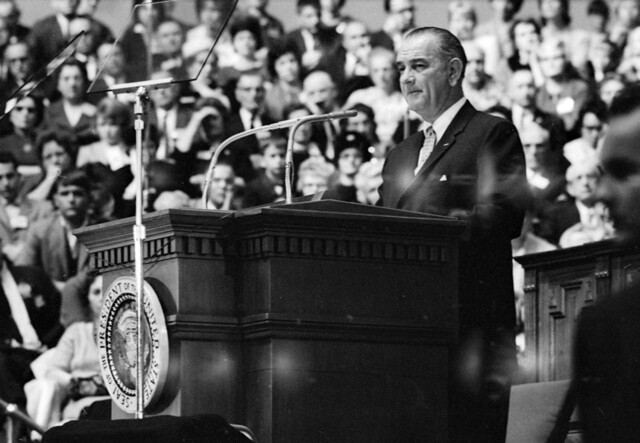
Photo from When the White House Comes to Zion,courtesy of Ronald L. Fox
October 29, 1964
President Lyndon B. Johnson, who was sworn in as President in 1963 after the assassination of President John F. Kennedy, made a stop in Salt Lake City while campaigning for the next election.In his address at the Tabernacle on October 29, 1964, President Johnson talked about a “heartening response” from the Soviet Union towards peace. A few quotes that probably resonated particularly with the Latter-day Saints included a reference to "We Thank Thee, O God, for a Prophet":
“I believe that we are entering a new era in the affairs of man. I am certain that we and the world really have two directions that we can go.
“We can, in the words of one of your old hymns, commit our efforts to moving ‘on to eternal perfection.’ Or we can, in folly and foolhardiness, allow the world to move recklessly toward eternal damnation.
“For whatever may unfold, you and I are cast in very decisive roles. This generation of Americans, more than any other, will decide by our example and our enterprise whether change shall serve creative or destructive purposes for humankind.”
He then later affirmed that:
“We are all God's children, and the true morality of private life is the true morality of a free society: the Golden Rule, do unto others as you would have others do unto you.”
11. Richard Nixon
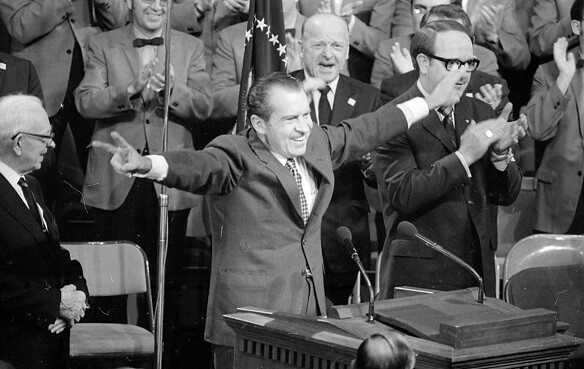
Photo from When the White House Comes to Zion, courtesy of Ronald L. Fox
Though President Richard Nixon spoke at the Tabernacle as a presidential candidate twice before, October 31, 1970, was his first time speaking from the pulpit as the President of the United States. Since America was in the midst of the Vietnam War, the president gave an update on progress towards peace. Always enamored by the Tabernacle Choir, President Nixon said in the introduction to his speech:
“I would like to pay my respects, too, to those who have preceded me on the program, to the magnificent Tabernacle Choir. I was so honored that they came to our inauguration. And I hope they sing another number at the conclusion of my speech. I am going to quit a little early so they can have the time.”
He concluded by paying high tribute to the religiosity of the Latter-day Saints:
“As you know, we have instituted a custom of having worship services in the White House, and we have taken a little heat for that, as you do for making any new breakthrough or new decision. We have done it because I felt it was important to bring to the Nation's Capital representatives of various faiths, and most have been represented, but particularly to bring right to the White House, where the President, members of the Cabinet, the members of the diplomatic corps, the Members of the Congress, Democrat and Republican, could be reminded of the fact that while this Nation is the strongest nation in the world and the richest nation in the world, that all the wealth and the strength in the world is as nothing unless the spirit of America is sound and good.
“And I do not know of any group in America—and I would say this not only here, but in other places in this country—who have contributed more to that strong, moral leadership and high moral standards, the spirit that has kept America going through bad times as well as good times—no group has done more than those who are members of this church."
12. Jimmy Carter

Photo from When the White House Comes to Zion, courtesy of Ronald L. Fox
On November 27, 1978, President Jimmy Carter was presented with the Family Unity Award by President Spencer W. Kimball during National Family Week. In his subsequent speech at the Tabernacle, he started by saying:
“I'm honored to be here with you in this beautiful place. I came a little earlier than the audience may have known, and I was pleased to watch the absolutely delightful and memorable television spots that remind all of us who are members of families what our duties are, to hear the Primary Children's Chorus singing "I Am a Child of God," to hear the . . . Native Americans, singing "Go, My Son," and then, of course, to come in and meet the Osmond family, which is a very famous and admirable group in our Nation.”
He then later said:
“Your great church epitomizes to me what a family ought to be—a church that believes, through moral imperative, in strong families, in individualism, the right to be different, but the opportunity and even duty to grow as a human being, to prepare oneself for greater service. The relief society organized by your church has brought blessings to tens of thousands of people, not in a highly publicized way, but in a quiet and effective way.”
BONUS:
13. Helen Keller

Photo from the Library of Congress
Helen Keller’s visit to Salt Lake City in March 1941 was highly publicized. She attended a benefit performance at the Tabernacle on the night of her arrival, received a Braille copy of the Book of Mormon from President Heber J. Grant, and spoke in the Tabernacle.
Newspapers of the time reported, “Describing herself as ‘inexpressibly grieved by the present world conflict,’ Miss Keller reaffirmed her belief in the power of God to eventually achieve His divine wish for ‘peace on earth, good will among men.’”
Famous Latter-day Saint poet Emma Lou Thayne recalls a particularly touching moment from Keller’s visit, when at the end of her speech, she asked for President Heber J. Grant:
“There was a flurry of getting up from the front row, and President Grant walked up the stairs to the stand. She reached out her hand and he took it. ‘I would like,’ she said, 'to hear your organ play your famous song—about your pioneers. I would like to remember hearing it here.’”
Keller placed her hand on the organ while the organist, Alexander Schreiner, played “Come, Come, Ye Saints.” Feeling only the vibrations from the magnificent instrument and organist's efforts, she stood there in front of the congregation, and the tears flowed.
14. Susan B. Anthony
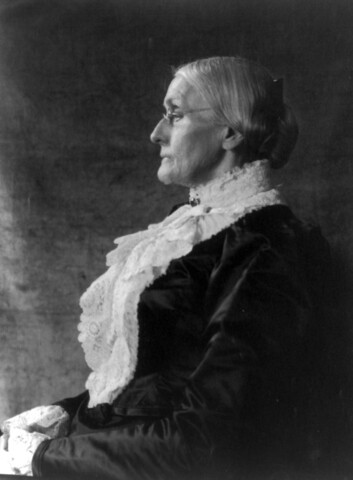
Photo from the Library of Congress
Susan B. Anthony, one of the leaders of the nation's women’s suffrage movement, visited Salt Lake City several times. The first time was in June 1871, when she came with her contemporary and friend Elizabeth Cady Stanton.
The two conducted a five-hour meeting with an audience full of Latter-day Saint women in the “Old Tabernacle,” which stood where the Assembly Hall on Temple Square stands today. Anthony, who later wrote about the event, expressed that they “were very thankful for the privilege granted us of speaking to the women alone in the smaller Tabernacle. Our meeting opened at two o'clock and lasted until seven, giving us five hours of uninterrupted conversation.”
Many years later, on May 12, 1895, Anthony came again to Salt Lake City, at the time when Utah was finally about to be granted statehood and when the right for women to vote was added to the constitution of the new state. This time, Anthony spoke in the large Tabernacle familiar to Latter-day Saints today.
The Woman’s Exponent, run at the time by the General Relief Society President and a friend of Anthony, Emmeline B. Wells, included the text from Anthony’s speech in one of their issues. Amidst her praise of the territory’s decision to allow women equal voting rights, she also gave this glowing praise of the Tabernacle:
“It is just about twenty-four years ago that I was present in this great Tabernacle on the day upon which you dedicated it to the service of the Lord, and every nook and corner, of this great building was packed on the occasion with people from every part of the Territory, many being unable to gain admittance. It was the most magnificent gathering I ever saw, and it was brought together in the midst of the greatest trouble that any people who were seeking to do right could go through” (Vol. 24, pg. 2).
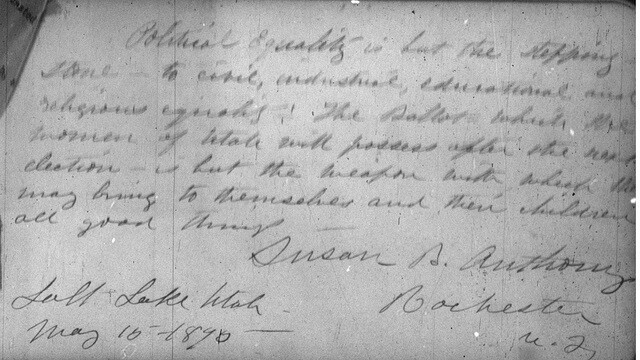
Photo from the U.S. Post Office, courtesy of Ronald L. Fox
In a note in Eliza R. Snow's autograph book a few days after her 1895 visit, Anthony also said of the women of Utah:
"Political Equality is but the stepping stone—to civil, industrial, educational, and religious equality; The Ballot which the women of Utah will possess after the next election is but the weapon with which they may bring themselves and their children all good things."
15. Charles A. Lindbergh
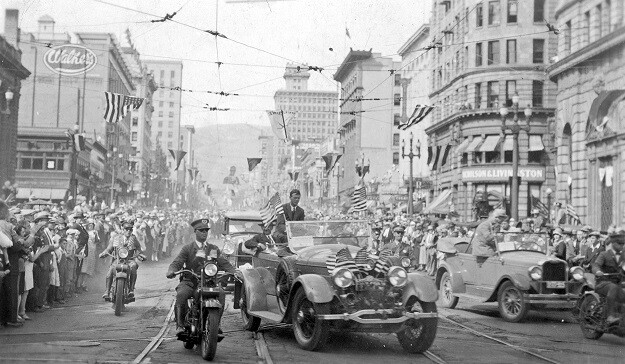
Photo from the Salt Lake Police Department, courtesy of Ronald L. Fox
As the first man to ever fly across the Atlantic Ocean, Charles A. Lindbergh was warmly welcomed to Salt Lake City on September 3, 1927. Thousands came to see him land on the little Woodward flying field, which would later become the Salt Lake International Airport.
The Improvement Era from the time reports:
“The city was gaily decorated with flags and bunting, the shop windows displayed pictures of the flier in all possible and impossible poses. Thousands of admirers, male and female, thronged the flying-field, the streets, Liberty Park, and the Tabernacle, to see and hear the famous bird-man, who gave the impression of being tired of all the fuss, not to say bored by it. However, the Colonel acknowledged the enthusiasm of Salt Lake City’s population . . . he is a clean young man, with unusual strength of character and unsurpassed courage and skill in his line of activity.”




